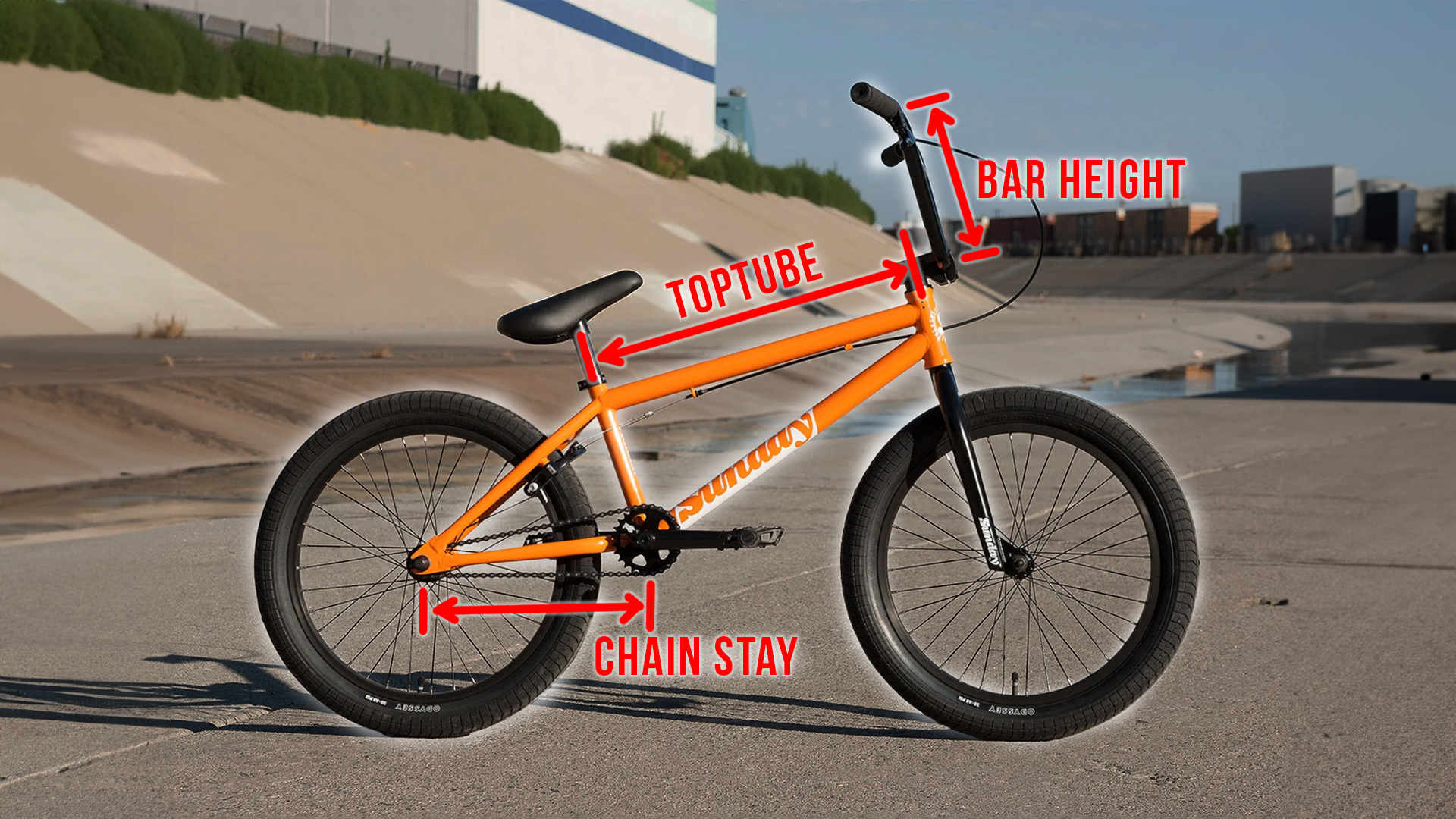BMX bike sizing is a critical aspect of the sport that directly influences your performance, control, comfort, and safety. By understanding the importance of bike sizing and the key measurements involved – including the top tube length, bar height, crank length, and more – you can optimize your ride and avoid potential injuries. This guide will take you through the nuances of BMX bike sizing to help you find the right fit.
Every component of a BMX bike – the frame, top tube, chain stay, bottom bracket, stand over height, and head tube angle – plays a significant role in determining the bike’s performance and feel. Among these, the top tube length is often considered the most critical measurement. However, the interplay between these dimensions makes it impossible to judge a bike’s sizing based on a single spec. With that in mind, let’s dive into the nitty-gritty of BMX bike sizing.
Importance
Why is the Right BMX Bike Size Important?
Why is the Right BMX Bike Size Important?
Choosing the right size for your BMX bike is crucial to your performance, control, comfort, and safety. The bike size impacts every aspect of your ride, from speed and balance to maneuverability and risk of injuries.

Impact on Performance
Your BMX bike’s size directly impacts your performance on the streets or park. The correct size can enhance your speed, balance, and maneuverability, offering you the freedom to perform complex tricks and maneuvers. A well-fitted bike responds better to your movements, allowing you to move fluidly and seamlessly.
Relevance to Safety
Riding a BMX bike that is not the right size can pose safety risks and increase the chance of injuries. A bike that is too big might be difficult to control and maneuver, leading to accidents. Similarly, a bike that is too small might cramp your riding style, increasing the chance of slips and falls. Additionally, using a bike that doesn’t fit can result in discomfort and long-term health problems related to poor posture.
Determining Factors
What Factors Determine the Right Size of a BMX Bike?
What Factors Determine the Right Size of a BMX Bike?
Choosing the right size of a BMX bike can be determined by various factors such as the rider’s height, arm length, leg length, and personal preference. Each of these elements plays a crucial role in influencing the overall feel and performance of the bike.
Role of Rider’s Height
Height is a fundamental parameter in determining the size of a BMX bike that one should ride. As a general rule, taller riders typically need bikes with a longer top tube length, while smaller riders can comfortably ride bikes with a shorter top tube length. The top tube length, running along the top of the bike, is arguably the most critical dimension of the frame, influencing control, balance, and responsiveness.
Top Tube Length Variations:
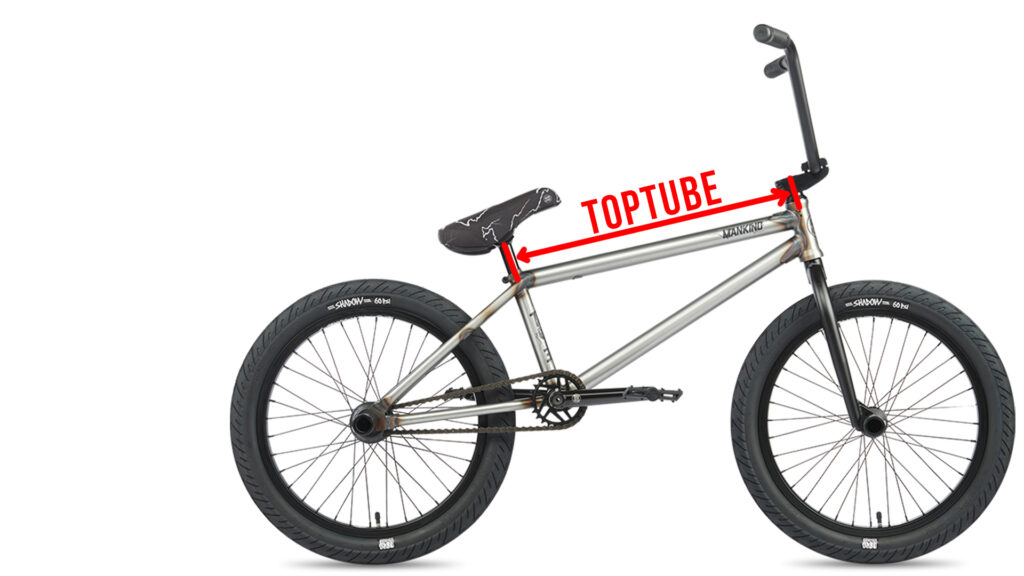
Your top tube length can range from 20.00 to 21 inches, and with aftermarket frames, you can even find more precise increments like 20.4, 20.6, 20.7 inches, enabling you to fine-tune your top tube size. This might seem like small differences, but even a quarter of an inch can have a drastic effect on your riding. So, it’s important not to overlook the significance of top tube length.
Below is a general size guide that you can use to consider which Top Tube size is right for you.
| Toptube Size | Recommended Height (USA) | Recommended Height (Not USA) |
|---|---|---|
| 20.00″ | 4′ 10″ to 5′ 3″ | 1.47m to 1.60m |
| 20.25″ | 5′ 3″ to 5′ 6″ | 1.60m to 1.68m |
| 20.5″ | 5′ 6″ to 5′ 9″ | 1.68m to 1.75m |
| 20.75″ | 5′ 9″ to 6′ | 1.75m to 1.83m |
| 21″ | Over 6′ | Over 1.83m |
| 21.25″ | Way Over 6′ | Way Over 1.83m |
Impact of Arm and Leg Length
The length of your arms and legs also play a vital role in determining the correct size of your BMX bike. This impacts the bar height and the crank length, which ultimately affects the performance and feel of the bike.
Typically these parts are adjusted by upgrading them with aftermarket parts. When buying a complete bike there is some variance in bar height and crank length, but you have a lot more options when changing those parts with after market upgrades.
Standover Height:
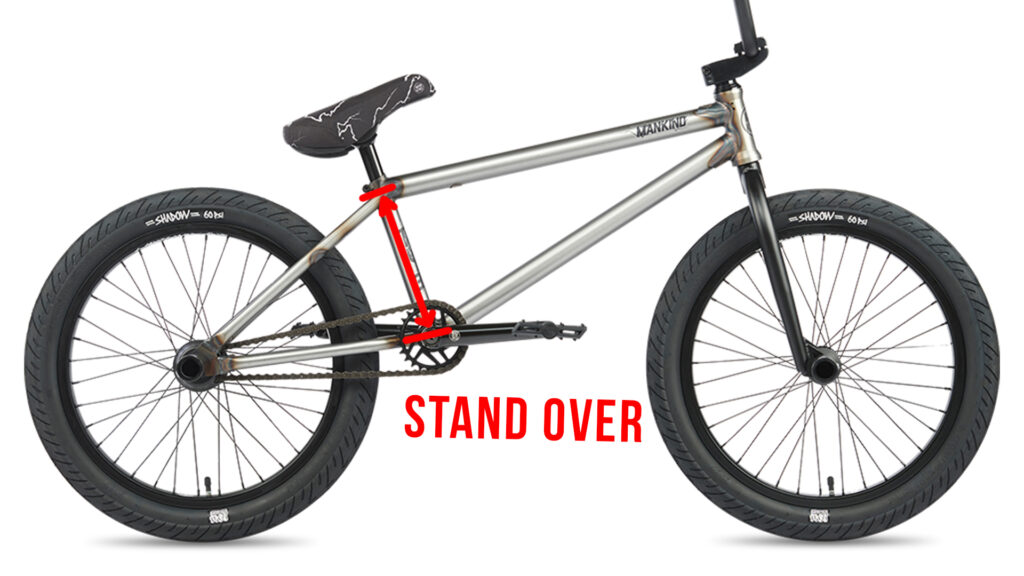
The standover height, essentially the length of the seat tube, affects the angle of the top tube and the amount of room you have to maneuver when doing tricks like tail whips or bar spins.
A shorter standover height will make it harder to pinch the seat during bar spins but easier to kick tail whips.
Conversely, a taller standover height makes pinching easier but tail whips harder.
Head Tube Angle:
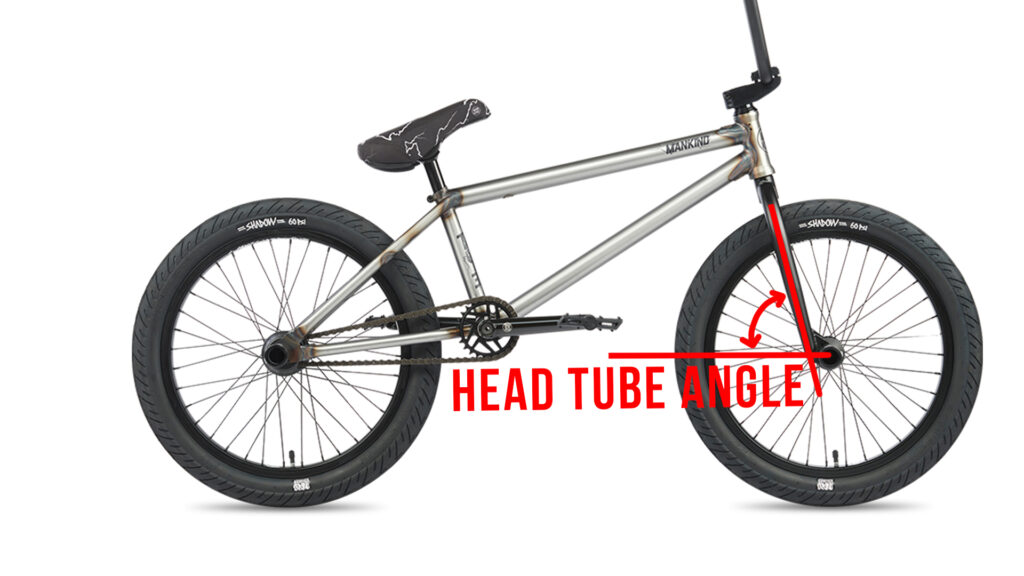
The head tube angle, the angle at which the head tube is positioned, significantly influences the bike’s responsiveness.
A steeper head tube angle will make the bike more responsive and snappy when taking turns or diving into nose manuals.
A more mellow head tube angle will be better for trails or going really fast in the skate park as it provides a more flowy, controlled feeling.
Bottom Bracket Height:
This often-overlooked parameter, the height of the bottom bracket from the ground, impacts how responsive the bike feels. A higher bottom bracket will make the bike feel more responsive, snappier in corners, whereas a lower bottom bracket gives a more mellow, grounded feel.
Chain Stay Length:
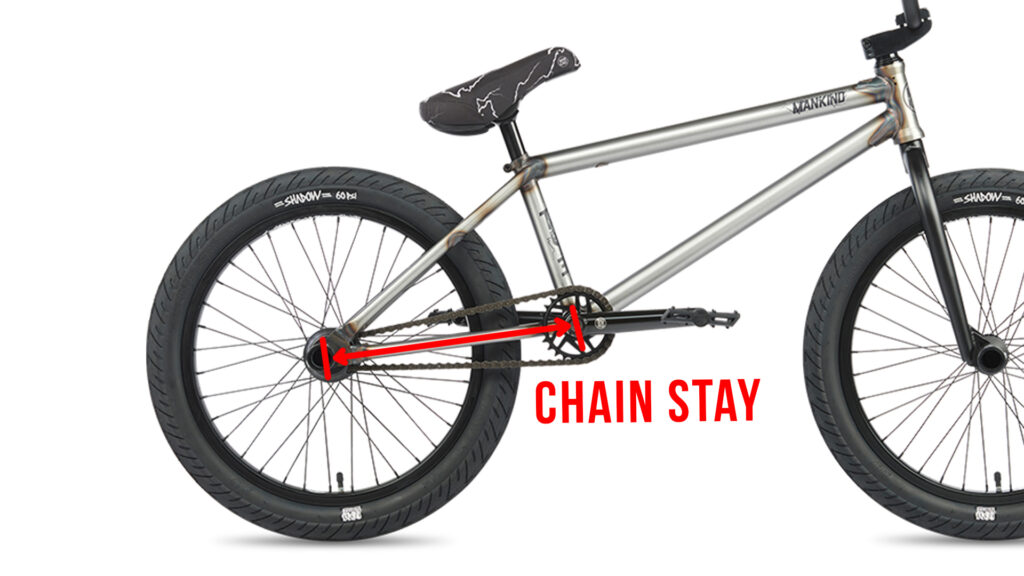
Chain stay length, measured from the bottom bracket to the end of the chain stay, also significantly impacts the bike’s feel. A longer chain stay lengthens the wheelbase, making the bike feel more stable and controlled. Conversely, a shorter chain stay makes the bike feel snappier, but controlling it at high speeds becomes more challenging.
Understanding these elements and how they relate to your physical dimensions and riding style is essential for choosing the right size of BMX bike. Remember, the bike size isn’t just about your height – it’s also about your reach (arm length), your inseam (leg length), and what feels most comfortable and efficient for you.
Measuring For Fit
How to Measure for the Perfect BMX Bike Fit?
How to Measure for the Perfect BMX Bike Fit?
Knowing how to accurately measure for the perfect BMX bike fit is crucial to ensure an optimal riding experience. There are key measurements such as the top tube length, the bar height, and the crank length that you need to get right to ensure comfort, safety, and top performance.
Measuring Top Tube Length
The top tube length, arguably the most important measurement, is the length from the seat tube to the head tube, running along the length of the top tube. This dimension influences control and responsiveness, significantly affecting the ride feel. It varies with different rider heights, with shorter riders typically needing a top tube length of around 20.00-20.25 inches, while taller riders might require closer to 21 inches. Aftermarket frames offer even more size increments, allowing riders to fine-tune their bike sizes to their preferences.
However, it’s important to note that a slight deviation in top tube length can drastically affect your ride. A top tube size slightly larger than recommended tends to offer more control and a “flowy” feel. Conversely, a smaller top tube size results in a more responsive and snappy riding experience. Therefore, measuring your top tube length accurately is critical, especially when purchasing a used bike.
Calculating the Ideal Bar Height
Another key measurement is the bar height, which is influenced by your arm length. This refers to the vertical distance from the bottom of the bike’s stem to the top of the handlebars. The right bar height allows for better control and less fatigue, particularly during extended rides or demanding BMX disciplines.
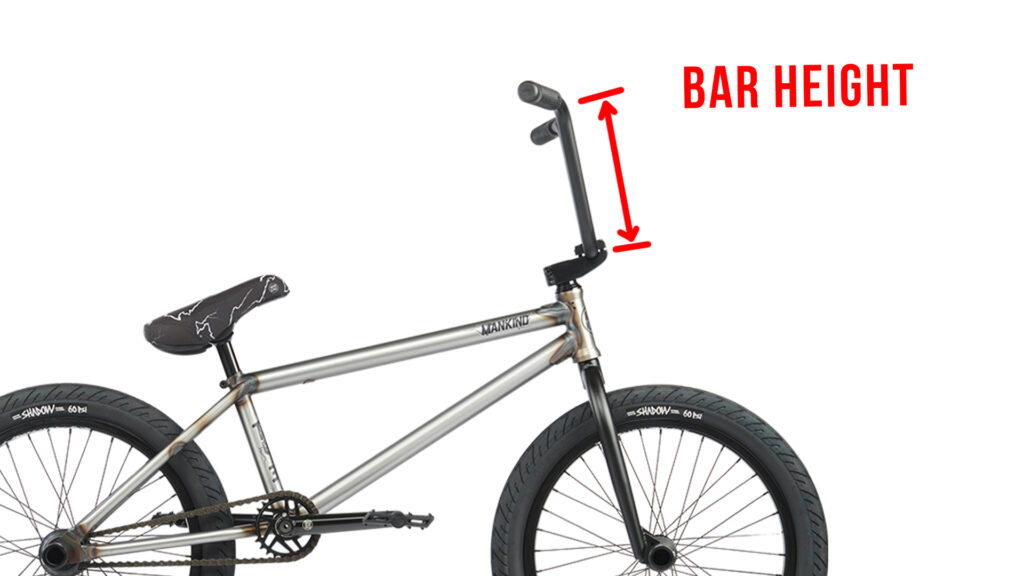
Determining the ideal bar height often comes down to personal preference and the rider’s specific BMX discipline. However, as a rule of thumb, when standing next to the bike, the handlebars should reach somewhere between your hips and waist. Remember, a bike with higher handlebars tends to offer more control, especially for taller riders, while lower handlebars may be more comfortable for shorter riders or those who perform many tricks.
Other things impact your “stack height” and the overall height of the top of your bars. These include the stem rise, and the fork tube length. Personally I like to have my bars a little bit lower than normal because it feels easier to pop on the bike.
Determining the Right Crank Length
Lastly, the crank length, which refers to the distance from the center of the bottom bracket to the center of the pedal spindle, is a crucial aspect of bike fit. This measurement directly affects the pedaling mechanics and, ultimately, the rider’s comfort and pedaling efficiency. Typically, crank length in BMX bikes ranges from 165mm to 180mm, with most riders choosing between 170mm and 175mm.
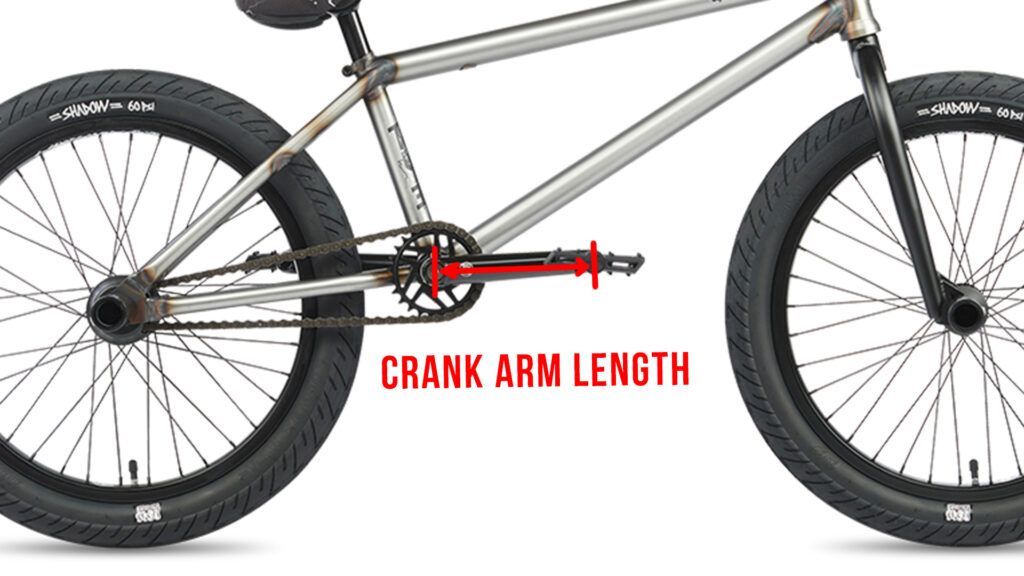
However, there isn’t a one-size-fits-all rule here. The appropriate crank length is mostly dependent on the rider’s leg length and the bike’s intended use. For instance, shorter cranks offer better pedaling clearance and are generally preferred for street riding, where tricks and stunts are common. On the other hand, longer cranks can provide more leverage and are usually preferred for BMX racing, where acceleration and speed are paramount.
Riding Style Impact
How Does Riding Style Influence BMX Bike Size?
How Does Riding Style Influence BMX Bike Size?
Your riding style significantly influences the size of your BMX bike. Different BMX disciplines, such as racing, street, park, and dirt riding, may require different bike sizes. The right size ensures optimal performance and enhances your control and safety.
Bike Sizing for Racing
The right bike size for BMX racing is different from other disciplines. BMX racing involves a lot of speed and maneuverability, which requires a bike that fits perfectly with the rider. The dimensions of the frame, especially the top tube length and standover height, play a crucial role. A longer top tube can provide more control and flowy riding, which is vital for BMX racing.
Racing bikes have a long chain stay which gives them insane stability. You can ride at high speeds through the track and it feels very stable.
Street and Park Riding Size Considerations
Street and park riding require a bike that can easily take sharp turns, do nose manuals, and withstand technical riding. A bike with a steeper head tube angle and a shorter chainstay can provide these benefits. A steeper head tube angle makes the frame responsive, while a shorter chainstay shortens the wheelbase, making the bike feel more responsive. It also allows the bike to feel really snappy, making spins easier. However, controlling the bike at high speeds may not be as easy.
If you plan to ride street or park consider the following:
- Gyro brake system
- Short Chain Stay (less than 13″)
- Steep Head Tube Angle (Steeper than 75º)
Sizing for Dirt Riding/Pump Tracks
Dirt riding is about control and safety as much as it is about thrill and adrenaline. Dirt riders often prefer a bike with a mellow head tube angle and a higher bottom bracket height. A mellow head tube angle provides a more flowy and controlled ride, which is crucial when navigating uneven terrains. On the other hand, a higher bottom bracket height makes the bike feel more responsive and snappy, which is helpful when taking corners on a dirt track.
A long chain stay and bigger sprocket are other things that impact your bmx riding on dirt jumps in a positive way.
If you plan to ride dirt jumps or pump tracks consider the following:
- Longer Chain Stay (over 13″)
- Mellow Head Tube Angle (Less than 75º)
Still Growing?
What to Do If You’re Still Growing?
What to Do If You’re Still Growing?
For younger BMX enthusiasts, one of the key challenges they face is related to their consistent growth. As children and teenagers grow, their bike size requirements also change. This creates a unique situation where they may outgrow their bikes faster than adults. It is essential to consider this factor when purchasing a BMX bike for a younger rider and find a balance that does not compromise their safety and comfort.
Picking a Size for a Kid that is Growing
The ideal size for a growing rider is one that they can comfortably ride now, but which also provides some room for growth. This doesn’t mean buying a bike that’s too large for them, as that could lead to loss of control, discomfort, and safety risks. The goal is to find a bike that’s slightly on the larger side of what fits them right now.
When choosing a bike for a growing rider, consider the standover height and top tube length. A taller standover height might be more challenging to manage initially, but it provides more room for growth. Similarly, a slightly longer top tube might feel a bit large at first but will accommodate the rider as they grow taller.
For someone who is still growing, consider buying a BMX bike that is .25″ taller than the current recommended height. for example. someone who is 5′ 2″ should ride a 20.00″ toptube BMX bike, but if they are still growing, they should buy a BMX bike with a 20.25″ toptube.
Please note that is it very possible that they will outgrow this size eventually but it would be better to upgrade the frame when the time comes instead of buying a 20.5″. Buying a frame that is half an inch taller than recommended for a new rider would be too much for them to control and make BMX an unenjoyable experience.
Remember, while size is a significant factor, so is the rider’s skill level. If the rider is a beginner, it might be better to prioritize a size they can handle confidently over one they will grow into.
Regular Check-Ins and Adjustments
As a young rider grows, the bike that was a perfect fit a few months ago might become too small. That’s why regular check-ins on how the bike fits are crucial. Keep an eye on how the rider interacts with the bike. If they seem cramped or uncomfortable, it might be time for adjustments or even a new bike.
Eventually, there will come a point when no more adjustments can be made, and a larger bike will be necessary. Be prepared for this and consider it as an essential part of the BMX journey for young riders. Remember, the ultimate goal is to ensure they are riding safely and comfortably, which will enable them to enjoy and excel at the sport.
22″ BMX vs. 20″ BMX
What is a 22″ BMX Bike and How is it Different from a 20″ BMX Bike?
What is a 22″ BMX Bike and How is it Different from a 20″ BMX Bike?
BMX bikes don’t solely come in the standard 20″ wheel size. For riders who prefer a different riding experience, BMX bikes with 22″ and 24” wheels are viable options. Choosing larger wheel sizes brings a different dimension to your BMX journey and understanding how to size these bikes accurately is essential for maximizing performance and comfort.
What is a 22″ BMX Bike?
A 22″ BMX bike refers to a bike with 22″ wheels. The number indicates the diameter of the wheels. Introduced in the past decade, 22″ BMX bikes offer a middle ground between the traditional 20″ BMX bikes and the larger 24″ cruiser bikes.
The 22″ BMX bike is designed for a more comfortable ride while maintaining the agility and versatility typical of BMX bikes. They are especially suited for taller riders or those seeking a more stable and comfortable ride without sacrificing the trick capabilities of a 20″ bike.
How is it Different from a 20″ BMX Bike?
While the primary difference lies in the wheel size, the implications of this difference are more far-reaching. A 20″ BMX bike is the industry standard and is designed for a broad range of BMX disciplines, from racing to freestyle to park riding. However, the 20″ BMX bike can sometimes feel a bit cramped for taller riders or those who prefer a larger bike.
On the other hand, the 22″ BMX bike, with its larger wheels, offers a more comfortable riding experience, particularly for taller riders. It retains the ability to perform tricks like a 20″ BMX, but provides more stability, especially at higher speeds. This makes it an excellent choice for riders who want the flexibility of a BMX but in a slightly larger package.
It’s essential to remember that while these differences exist, choosing the right size largely depends on personal preference and the specific riding style one is into.
What height is right for a 22″ BMX Bike?
Typically a 22″ BMX bike is good for riders that are over 6′. But please note that a 22″ BMX bike has a really long wheelbase which will make responsive riding and big tricks harder to do.
| Bike Size | Recommended Rider Height (ft & in) | Recommended Rider Height (m) |
|---|---|---|
| 22″ BMX | 5’8″ – 6’6″ | 1.73 – 1.98m |
| 24″ BMX (Cruiser) | 5’10” – 6’6″ | 1.78 – 1.98m |
| 26″ BMX (Cruiser) | 5’11” – 6’4″ | 1.80 – 1.93m |
Sizing Adjustments for Larger Wheels
When opting for larger wheel sizes, there are several adjustments and measurements to consider for optimal sizing. In general, bikes with larger wheels have longer top tube lengths, providing more space for the rider. However, riders must be aware of this as it can affect their ability to perform certain tricks.
Similarly, the bottom bracket height and standover height might also differ on these bikes, potentially leading to a different feel when riding. These are factors you should keep in mind when deciding on a BMX bike with larger wheel sizes.
Common Mistakes
Common Mistakes in BMX Bike Sizing
Common Mistakes in BMX Bike Sizing
The most common BMX sizing mistakes are overlooking personal comfort and preference, ignoring adjustments and fine tuning, and buying a bike based on looks/quality instead of size.
Overlooking Personal Comfort and Preference
One of the most common mistakes made in BMX bike sizing is disregarding personal comfort and preference. Many riders focus on numbers and forget that comfort should be at the heart of their decisions. BMX biking is about enjoying the ride, and a bike that feels right to you can enhance that experience significantly.
The top tube length, arguably the most crucial dimension of the frame, is something that people tend to overlook. Riding a bike that’s even a quarter of an inch too big or too small can drastically affect your riding experience. If you’re a taller rider, you might opt for a 21″ top tube, while a smaller rider might prefer a 20.00″ or 20.25″.
The standover height, which affects how much room you have to kick tail whips, pinch for barspins, or grab for toboggans, can also impact your comfort and performance. A lower standover height offers more room for tricks but can make pinching more challenging, while a higher one is easier to pinch but harder to get your feet over for tail whips.
Ignoring Adjustments and Fine-Tuning
Another common error is ignoring the importance of bike adjustments and fine-tuning. Even when you’ve got the right size, fine-tuning your bike to fit your riding style and preference is paramount. Several frame specs play integral roles in how your bike performs and feels, and making necessary adjustments can significantly enhance your riding experience.
The head tube angle determines the responsiveness of your bike. A steeper angle results in a more responsive and technical ride, while a more mellow angle provides a more controlled and flowy feel.
The bottom bracket height, often overlooked, determines how close to the ground you are when you ride. A higher bottom bracket results in a snappy, responsive feel, while a lower one gives a more mellow, grounded ride.
Lastly, the chainstay length affects the wheelbase of your bike. A longer chainstay results in a more stable, controlled feel, while a shorter one gives a snappy, responsive ride. Ignoring these adjustments and simply sticking to standard measurements can rob you of the personalized, fine-tuned ride that suits your style best.
Buying Based on Color/Quality and Not Size
Many people look at a BMX bike that LOOKS nice or has high quality and they make their decision based on those factors instead of looking at the most important thing… the size. Buying a BMX bike that is the right size is the most important thing you can do because this will ensure that you are able to maneuver the bike and learn tricks.
Choosing the Right Bike Size is crucial for several reasons:
- Comfort: A bike that is the right size for your body will be much more comfortable to ride. An appropriately sized bike will ensure that you are not overstretched when reaching for the handlebars or pedals. On a bike that’s too big, you may struggle to reach the pedals or the handlebars, which can cause discomfort or even lead to injury over time.
- Control: When a bike fits you properly, you’ll have better control and balance when riding. A bike that is too big or too small could be difficult to control, making you more prone to accidents.
- Efficiency: The right bike size will allow you to pedal efficiently and make the most of your energy, especially over longer distances. If your bike is too big or too small, you may have to exert more effort to achieve the same speed or to travel the same distance as you would on a bike that is the correct size.
- Injury Prevention: Incorrect bike size can lead to improper posture when riding, potentially causing strains or other injuries over time. For example, a bike that is too small could cause you to hunch over, which might lead to back or neck pain.
While looks and quality are also important, they should not be the main determinant in your bike choice. A good-looking, high-quality bike will not be beneficial if it’s the wrong size for you.
Remember, your safety and comfort are paramount, so always prioritize the bike size that fits you best.
Conclusion
Conclusion: Why is Correct BMX Bike Sizing Essential?
Conclusion: Why is Correct BMX Bike Sizing Essential?
Understanding and selecting the correct BMX bike size is critical for optimizing performance, ensuring safety, and enhancing the overall riding experience. The complexities involved in BMX bike sizing revolve around various aspects, from the rider’s physical dimensions to their riding style and personal preference. This guide has walked you through all these factors, providing comprehensive information to assist you in finding your perfect BMX bike fit.
The Final Recap: What Have We Learned About BMX Bike Sizing?
Firstly, the guide emphasized the paramount importance of the right BMX bike size, outlining its significant impacts on performance, control, comfort, and safety. It highlighted the need to consider factors such as rider height, arm length, leg length, and personal preference when determining the right bike size.
Additionally, we delved into practical measurement procedures for a perfect BMX bike fit, focusing on the top tube length, bar height, and crank length. The guide elucidated how each element contributes to the bike’s overall size and performance.
The influence of riding style on bike size was another vital topic discussed. We discovered how BMX disciplines like racing, street, park, and dirt riding necessitate unique sizing considerations. For young riders who are still growing, the guide provided insights into balancing immediate fit and future growth.
For those interested in larger wheel sizes like 22″ and 24”, we provided considerations and adjustments to account for these dimensions. Throughout the guide, we made sure to draw attention to common sizing mistakes, emphasizing the need to factor in personal comfort and the importance of adjustments and fine-tuning.
Why Does All This Matter?
Choosing the correct BMX bike size is more than just a matter of comfort—it can significantly impact your riding skills and safety. A bike that doesn’t fit you well can be challenging to control, may cause unnecessary strain or discomfort, and can even lead to accidents.
Every BMX rider is unique, and the ‘one-size-fits-all’ approach does not apply here. Paying attention to bike sizing ensures that your BMX bike is a true extension of your body, providing the best possible control, responsiveness, and enjoyment out of your BMX riding experience.
So take the time to understand these factors and make an informed decision about your BMX bike size. It’s a critical step towards achieving your best performance, staying safe, and most importantly, maximizing your fun on the bike.
FAQ
Common Questions About BMX Bike Sizing
FAQ Section: Addressing Common Questions About BMX Bike Sizing
BMX bike sizing can be complex, with various factors such as rider height, arm and leg length, riding style, and personal preference playing significant roles. To further clarify the concept, let’s delve into some frequently asked questions that can help riders make an informed decision about their BMX bike size.
Can I ride a BMX bike that is a size bigger or smaller?
Yes, you can ride a BMX bike that’s slightly bigger or smaller than your ideal size, but it may affect your performance and comfort. A bike that’s slightly bigger can offer more stability and control but might be harder to maneuver, while a smaller bike can be snappier and more responsive, but may compromise control and comfort. Ultimately, it’s important to ensure that your bike size aligns well with your physical dimensions and riding style.
What should I do if my bike is the wrong size?
If your bike size isn’t right, it could lead to discomfort, loss of control, and potential safety risks. If the bike is too small, you might feel cramped and it could affect your ability to perform tricks and stunts. On the other hand, a bike that’s too big may be difficult to control. If you’ve determined that your bike is the wrong size, consider exchanging it for a size that better suits you. If that’s not possible, try adjusting components like the seat post or handlebars to help get a better fit.
Does the top tube length really matter?
Yes, the top tube length is arguably one of the most important dimensions of a BMX bike frame. It essentially determines how long the bike is from the seat to the handlebars. The length can range between 20.00″ to 21.00″ or even more with increments of 0.25″. A shorter top tube is suitable for smaller riders, whereas taller riders benefit from a longer one. A difference of even a quarter of an inch can drastically affect your riding experience, control, and comfort.
What does the term ‘standover height’ mean and why is it important?
The standover height is the length of the seat tube, and it determines how tall the frame is. This height affects your ability to control the bike while performing tricks like bar spins and tail whips. A shorter standover height gives more room to kick tail whips but can make bar spins harder to pinch, while a taller standover height makes pinching easier but tail whips harder. It’s essential to consider the standover height when choosing your bike.
How does head tube angle influence the ride?
The head tube angle is the angle at which the front of the bike is positioned. A steeper angle results in a more responsive ride, making it ideal for technical riding, turns, and nose manuals. On the other hand, a more mellow angle results in a flowy and controlled feeling ride, making it suitable for trails or riding fast in skateparks. It’s critical to align the head tube angle with your riding style and preferences.
What is the impact of the bottom bracket height?
The bottom bracket height is the distance from the ground to the center of the bike’s cranks. This height can affect the responsiveness and control of the bike. A higher bottom bracket height results in a snappier, more responsive feel, while a lower one offers a more grounded, mellow feel. It’s often overlooked, but it plays a key role in how the bike handles.
How does the chainstay length affect the ride?
The chainstay length is the distance from the bottom bracket to the rear wheel. A longer chainstay length provides stability and control, making it suitable for a mellow and flowy riding style. In contrast, a shorter chainstay length makes the bike feel snappy and responsive, making spins easier but high-speed control harder. Like other dimensions, chainstay length should align with your riding style.
What BMX Size is Best for a 9, 10, or 11 Year Old?
Most 9, 10 and 11 year olds need a lightwieght bmx bike that has 18″ or 20″ wheels. The toptube should be 19.5″ to 20.00″. Buying a bike that fit’s these specifications will ensure that the young rider is able to learn new BMX tricks and build basic bike control.
Overall, understanding BMX bike sizing is crucial for a safe and enjoyable riding experience. Remember, the best bike is the one that fits you perfectly and aligns with your riding style and preferences.
